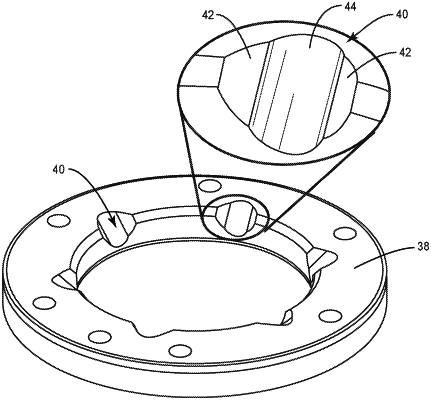| CPC B25J 15/0061 (2013.01) [B25J 15/0416 (2013.01); F16B 21/165 (2013.01)] | 10 Claims |

|
1. A robotic tool changer, comprising:
a tool assembly including a bearing race;
a plurality of spherical rolling members;
a master assembly including a plurality of bores, each configured to contain one of the plurality of spherical rolling members, and a cam having at least one tapered surface angled so as to urge the rolling members against the bearing race to couple the master and tool assemblies, and to allow the rolling members to retract away from the bearing race to decouple the master and tool assemblies;
wherein at least one of an inner surface of each of the plurality of bores and a corresponding plurality of positions on the bearing race include a cross-contact recess configured to seat a corresponding one of the rolling members when the master and tool assemblies are coupled;
wherein each of the cross-contact recesses of the plurality of bores or corresponding plurality of positions on the bearing race is generally cylindrical or spherical concave and has substantially a same radius as one of the plurality of spherical rolling members, and comprises a central void that does not contact the one of the plurality of spherical rolling members and two three-dimensional contact areas, each having a three-dimensional contact surface, one on either side of the central void, both of which contact the one of the plurality of spherical rolling members over respective corresponding three-dimensional contact areas of the one of the plurality of spherical rolling members when the master and tool assemblies are coupled, wherein each of the three-dimensional contact areas is greater than a point or line of contact.
|